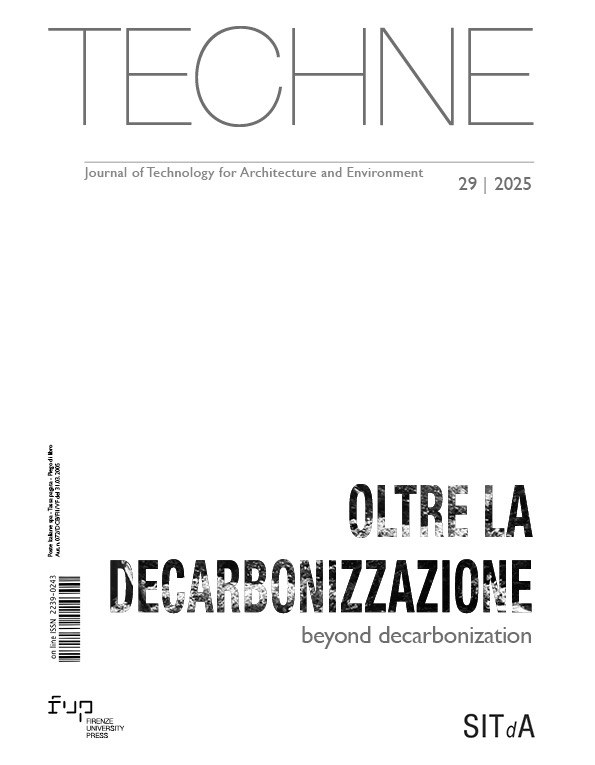Published 2025-07-31
Keywords
- Infrastructures,
- Embodied carbon,
- Embodied Energy,
- Building Information Modeling (BIM),
- Visual Programme Language
How to Cite
Copyright (c) 2025 Federica Gallina, Roberto Giordano, Massimiliano Lo Turco, Benedetta Quaglio, Andrea Tomalini

This work is licensed under a Creative Commons Attribution 4.0 International License.
Abstract
AMICO (Account Method of Infrastructures embodied CarbOn) is a research project conducted in partnership with Webuild group. The aim is to develop integrated tools for the analysis and evaluation of CO2 emissions (Embodied Carbon) and energy demand (Embodied Energy) of some phases of the infrastructure life cycle. The results of the study make it possible to identify which materials and processes have the most significant energy-environmental impact, and to define mitigation actions for progressive decarbonisation of the construction sector. In particular, the paper focuses on the importance of the project of digitising environmental data in a BIM environment.
Downloads
References
- Chen, S. et al. (2020), “Urban carbon footprints across scale: Important considerations for choosing system boundaries”. Applied Energy, 259 (114201), p. 114201. Available at: https://doi.org/10.1016/j.apenergy.2019.114201 (Accessed on 03 September 2024). DOI: https://doi.org/10.1016/j.apenergy.2019.114201
- Decreto Legislativo 31 marzo 2023, n. 36, Codice dei contratti pubblici (2023, 13 aprile). Gazzetta Ufficiale, (77 – Supplemento Ordinario 14).
- European Commission (2021), Green Deal Europeo – Raggiungere i nostri obiettivi, Publications Office of the European Union, Lussemburgo. Available at: https://data.europa.eu/doi/10.2775/029780 (Accessed on 05 September 2024).
- Fang, Z. et al. (2023). “A Systematic Literature Review of Carbon Footprint Decision-Making Approaches for Infrastructure and Building Projects”, Applied Energy, 335(120768), p. 120768. Available at: https://doi.org/10.1016/j.apenergy.2023.120768 (Accessed on 03 September 2024). DOI: https://doi.org/10.1016/j.apenergy.2023.120768
- Green Building Council Italia (GBC Italia) (2024), Position Paper – Smart Building: la digitalizzazione per il Net Zero. Available at: https://www.cognitoforms.com/GBCItalia1/SmartBuildingLaDigitalizzazionePerIlNetZero2 (Accessed on 15 November 2024)
- Kaewunruen, S., Sresakoolchai, J., and Zhou, Z. (2020). “Sustainability-Based Lifecycle Management for Bridge Infrastructure Using 6D BIM”. Sustainability, 12(6), p. 2436. Available at: https://doi.org/10.3390/su12062436 (Accessed on 03 September 2024). DOI: https://doi.org/10.3390/su12062436
- Royal Institution of Chartered Surveyors (RICS) (2023). Whole life carbon assessment for the built environment, 1st ed, September 2023. Available at:
- https://www.rics.org/content/dam/ricsglobal/documents/standards/Whole_life_carbon_assessment_PS_Sept23.pdf (Accessed on 05 September 2024).
- Soust-Verdaguer, B., Llatas, C., and García-Martínez, A. (2017), “Critical Review of BIM-Based LCA Method to Buildings”, Energy and Buildings, 136, pp. 110-120. Available at: https://doi.org/10.1016/J.ENBUILD.2016.12.009 (Accessed on 03 September 2024). DOI: https://doi.org/10.1016/j.enbuild.2016.12.009
- Wu, W., and Mehta, D. (2020), “Urban Infrastructure”. Urban Studies. Oxford University Press. Available at: https://doi.org/10.1093/obo/9780190922481-0022 (Accessed on 03 September 2024). DOI: https://doi.org/10.1093/obo/9780190922481-0022
- Yan, J. et al. (2022), “SeeCarbon: a review of digital approaches for revealing and reducing infrastructure, building and City’s carbon footprint”, IFAC-PapersOnLine, 55(19), pp. 223-228. Available at: https://doi.org/10.1016/j.ifacol.2022.09.211 (Accessed on 03 September 2024). DOI: https://doi.org/10.1016/j.ifacol.2022.09.211






